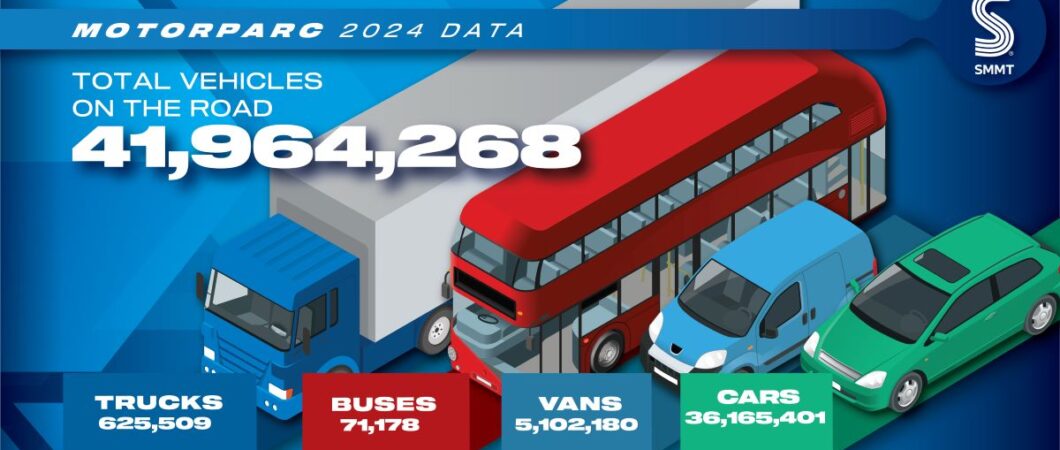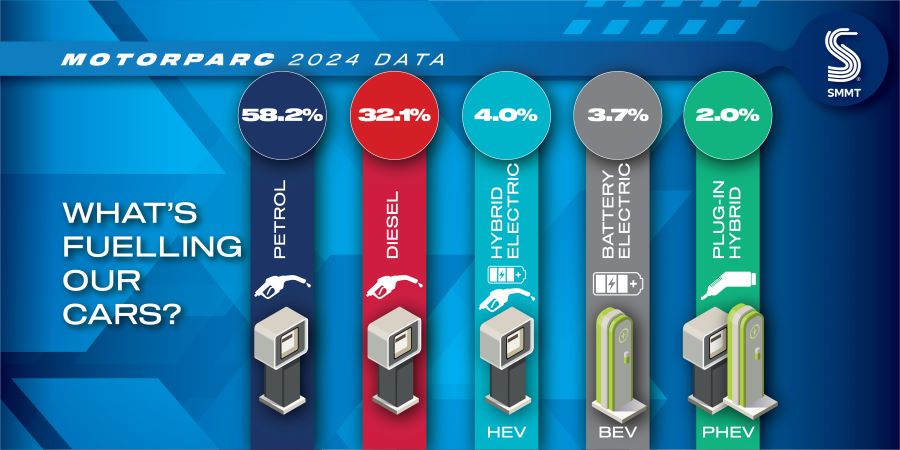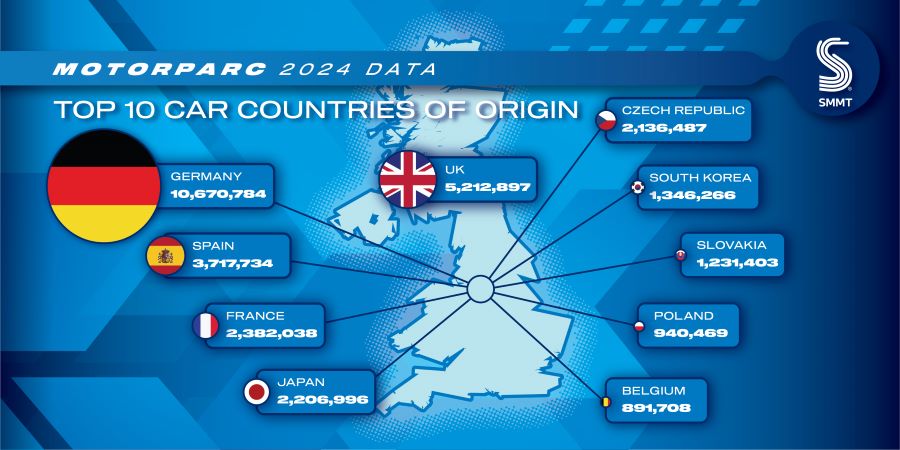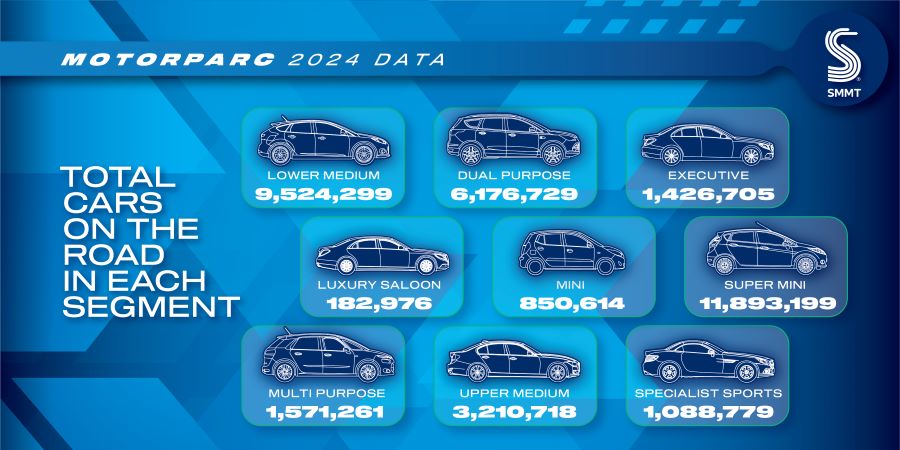The Society of Motor Manufacturers and Traders (SMMT) has just published its latest annual statistics for vehicles registered in the UK, aka the UK 2024 motorparc* data.
There are some interesting, if not entirely surprising, trends.
- In 2024 there were a record 42 million vehicles on UK roads, an increase of 1.4% on the previous year.
- The number of electric cars in use rose to 1.3 million, up an amazing 38.9% year on year!
- However, the vehicle renewal rate has slowed down as Brits hold on to their vehicles for longer, with 43.4% of the parc over 10 years old and average age of car in use rising to new high of 9.5 years.
In terms of reducing fossil fuel, what does this show?
Britain’s vehicle parc continues to decarbonise, with a 34.6% increase in plug-in vehicles (BEV and plug-in hybrid) – now accounting for one in 20 (5.1%), or 2,157,360, vehicles in use. Manufacturer discounting has driven up demand for battery electric cars which saw them remain the fastest growing sector of the parc. BEVs comprise 3.7% of cars in use, up a full percentage point on 2023.
However, conventionally fuelled cars remained the most dominant, with petrol-powered motors rising by 1.0% to 21.0 million, and an almost unchanged market share of 58.2%, while diesel volumes fell -4.4% to 11.6 million – making up 32.1% of cars in use – and marking the fuel type’s fifth straight year of decline.
Van use also grew to record levels, up 1.8% to 5,102,180 units, with more than one million of these workhorses added to roads since 2015.2 Heavy goods vehicle volumes remained almost unchanged, down just -0.1% or 364 units, at 625,509 units. Bus and coach volumes fell by just -0.1% to 71,718 units, although this means that the UK public transport fleet is now the smallest since records began.
The commercial vehicle parc is also decarbonising, with buses leading the way with an 81.8% increase in zero emission units on last year to 3,494 – accounting for almost one in 20 (4.9%) buses in use. Vans, which support businesses across the country, are also increasingly going zero-emission, with battery electric van volumes increasing by 31.6% to 80,476 units – or 1.6% of the parc. Electric truck use also rose, but overall they account for fewer than 0.1% of the fleet.
Lower uptake in the new car market means motorists are holding onto their cars for longer, with the average age of a car on the road now 9.5 years old, up from 9.3 years in 2023 and much older than the eight year-old average of 2019. More than two-fifths (43.4%) of the total parc has now been in use for more than a decade, predating the introduction of lower-emission Euro 6 technology which has done much to improve air quality.
SMMT Chief Executive Mike Hawes, commented: “There is scope to push environmental improvements much faster as motorists are holding onto their cars for longer, some one and half years longer on average, than only five years ago. Drivers need more incentives and greater confidence in infrastructure investment (I think he means fast charge points) if we are to replace the high volumes of older high-emission cars with zero-emission alternatives.”
Some fun facts from the data…
- Superminis remain the most popular car type in use, closely followed by lower medium models. These segments account for almost three out of five cars (59.2%) on the road, making up 11,893,199 and 9,524,299 units respectively.
- Germany was the largest source of cars on UK roads, accounting for 29.5%, with the UK (14.1%) the second and Spain (10.3%) the third. China is now the 12th largest source of cars.
- Black remains the most popular car colour of choice, accounting for more than one in five vehicles in use today (20.2%).
- Automatic transmissions continue to rise as more electric vehicles reach the road, up 9.5%, while manual transmissions have fallen -2.6%.
- For Wicked musical fans, 660,245 green and 24,863 pink cars were in use on UK roads last year.
- While red might seem the archetypal colour for buses, white coloured buses are actually the most popular – with 19,797 in use, equal to 27.8% of the fleet.
- London and the South East are home to the most cars (8,993,282), followed by the North West (4,007,590) and the South West (3,609,861).
- London and the South East is the region with the most registered EVs in use (456,289).
- Of all cars in use, 35.1% are registered to women and 51.1% to men,with a 4.0% increase in women owners over the last five years.3
- Almost six in 10 EVs are registered to companies, compared with companies accounting for just 10.0% of the overall car parc.
- The five most popular cars on UK roads in 2024 accounted for over 5,220,195 million in use – these are the Ford Fiesta at 1,465,402, Vauxhall Corsa at 1,035,440, Ford Focus at 1,004,153, Volkswagen Golf at 997,788 and Volkswagen Polo at 997,788.
- Unsurprisingly, white coloured vans remain the most popular at 2,745,635 units, but for those looking for a Scooby Doo ‘mystery machine’, there are 372,993 blue vans in use.
* “Parc” is a European term for all registered vehicles within a defined geographic region, originating from the French phrase “parc de véhicules” meaning the collective number of vehicles or a vehicle collection.












